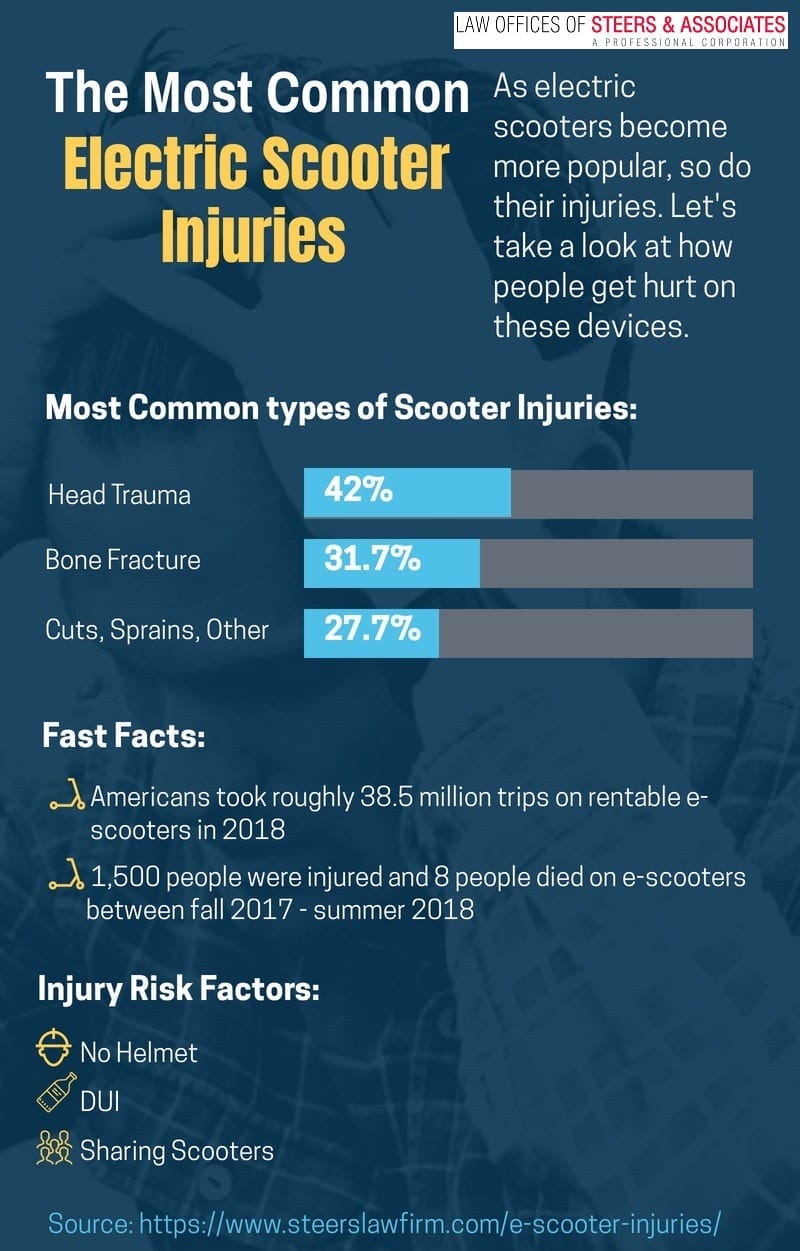As each month passes, e-scooters become an increasingly common sight on America’s roadways, bike lanes, and – unfortunately for urban planners – sidewalks. If you believe these devices are just a passing fad, you’d better think again.
A new study out of the National Association of City Transportation Officials found that Americans took roughly 38.5 million trips on rentable e-scooters in 2018. That’s more than total trips on shareable bike systems, which totaled 36.5 million. For most cities, it’s no longer a question of if, but when e-scooters will flood their streets.
Given that Bird Scooters and Thousand Oaks have an ongoing agreement within their city, the use of scooters has steadily risen in recent times.
 How Much Is Your Settlement Worth?
How Much Is Your Settlement Worth?
Schedule a completely free, no obligation consultation with our team
Schedule Consultation
All of the major worries city leaders have with e-scooters revolve around the issue of safety. Consumer Reports recently revealed eight people have been killed and another 1,500 injured while riding an e-scooter between autumn of 2017 and the summer of 2019.
To address these safety concerns, researchers have begun analyzing injuries related to e-scooter use. Although more work needs to be done, these early studies reveal a few trends that could help governments develop better infrastructure and effective public safety campaigns.
Want to learn more about the most common e-scooter related injuries? Let’s take a closer look at what two major studies have to say on the issue.
Important UCLA Info: The World’s First E-Scooter Study
The University of California, Los Angeles, has bragging rights for publishing the first study on e-scooter safety at the start of 2019. Researchers involved in this historic analysis examined records from two UCLA ERs between September of 2017 and August of 2018. In total, analysts found that 249 e-scooter patients with a mean age of 33 were admitted to these ER departments.
The vast majority of people injured in these cases were riding the e-scooter at the time of the crash. 228 patients were e-scooter riders versus 21 pedestrians. Study authors also pointed out 145 victims were men versus 104 women.
How Were People Getting Hurt?
The most common types of injuries sustained in electric scooter accidents include head trauma, bone fractures, and other injuries such as lacerations, sprains and contusions.
Let’s take a closer look at these injuries:
Request Your Free Consultation
"*" indicates required fields
Head trauma was the most common complaint these e-scooter patients had. UCLA doctors treated exactly 100 people for head trauma, which represents 40.2 percent of total e-scooter patients.
With 79 cases (or 31.7 percent of total e-scooter patients), the second most common injury was some type of fracture. In third place, 69 patients (27.7 percent) were admitted to the hospital for injuries not involving head trauma or fracture (e.g. lacerations, sprains, or contusions).
As study authors examined these three injury types, they found that 95 patients (38.2 percent) had some kind of head injury without internal bleeding or fracture. Only five patients (2 percent) had serious cranial hemorrhaging.
Of those with fractures, the most common injury sites were as follows:
- Distal upper extremity: 31 patients; 12.5 percent
- Proximal upper extremity: 17 patients; 6.8 percent
- Face: 14 patients; 5.6 percent
- Distal lower extremity: 11 patients; 4.4 percent
Thankfully, most of these patients didn’t require admission to the ER. Indeed, 94 percent of those injured by e-scooters (234 patients) were discharged. Only 2 of the 15 patients admitted into the ER needed to visit the intensive care unit.
Interestingly, the number of people injured on e-scooters was significantly higher than bicyclist and pedestrian, hoverboard injuries in the same time period. According to the research, there were 195 bicyclist injuries and 181 pedestrian injuries between 2017 – 2018.
Potential Risk Factors: Helmets, DUI, And Ride-Sharing
When looking at risk factors, scientists discovered 182 of these e-scooter riders (94.3 percent) weren’t wearing helmets at the time of their crash. They also found 7.8 percent of patients were sharing their e-scooter with another person and 4.8 percent had a blood alcohol content above 0.05 percent.
It’s important to note, however, that it’s no longer illegal to ride an e-scooter in California without a helmet on. Beginning on January 1, 2019, anyone over the age of 18 in the Golden State can legally ride e-scooters without helmets. For more on this new CA law, check out this official link.
By the way, if you’re interested in reading this entire study, check out the January 2019 edition of JAMA Network. Researchers appropriately entitled their study, “Injuries Associated With Standing Electric Scooter Use.”
The First Federal E-Scooter Study: CDC Data Out Of Austin
Along with UCLA, the Centers for Disease Control and Prevention (CDC) appears to be interested in the potential hazards of e-scooters. Working closely with public health officials in Austin, CDC employees recently reviewed incident reports and emergency room visits between September 5 and November 30, 2018. This data was formally released at the 2019 Epidemic Intelligence Service gathering in Georgia.
Although the study period was rather short, the CDC made a few intriguing discoveries. Most importantly, they gave us the first average for e-scooter injuries: 20 per 100,000 trips. In total, 271 people were injured in potential e-scooter accidents during this study’s timeframe.
How The CDC Report’s Injuries Compared With UCLA
Similar to the UCLA study, head injuries and fractures were most common. More people injured in Austin, however, suffered multiple injuries. As you’ll also see below, there were more severe injury cases in Austin compared with LA.
Analysts found that 70 percent of patients had some type of injury on their upper body and 55 percent had an issue on their lower limbs. 48 percent of victims had some type of mild head trauma and 35 percent had at least one bone fracture.
Thankfully, nobody in the Austin study passed away as a result of their injuries. On the other hand, about half of these patients had what doctors considered “severe injuries.” The most common of these serious injuries were bone fractures at 84 percent, but trauma to the nerves, tendons, and/or ligaments was also quite high at 45 percent.
When interviewed about their injuries, 37 percent of patients said speeding was a major contributor to their crash. An additional 33 percent of respondents said they had some amount of alcohol in their system 12 hours before riding. 19 percent of patients said a braking malfunction was the primary reason for their accident.
Helmet Issues In Austin Study
Helmet compliance was extremely low in the CDC study. Analysts said roughly one in 190 e-scooter patients was wearing a helmet at the time of their crash.
Like California, Texas currently doesn’t require helmets for e-scooter riders under the age of 18. Unlike California, lawmakers in Austin are considering a new bill (Senate Bill 549) that would make helmets a requirement for all e-scooter riders.
For those interested in learning more about Senate Bill 549, be sure to visit this official link. You could also read the entire CDC-Austin study by visiting this PDF.
Building Smarter, Safer Cities For E-Scooter Riders
Of course, both of these studies only give us a rough idea of e-scooter injuries at the present moment. As with any new device, it’ll take a while before people adjust to operating e-scooters in urban settings. There are, however, many proactive steps riders and city leaders could take to prevent severe injuries in the future. Of course, creating more bike-protected lanes will go a long way to promoting the safe use of micro-mobility devices. Public safety campaigns explaining how to ride e-scooters and the importance of helmets could also help reduce the number of injuries and fatalities.
For more information on e-scooter safety, people are encouraged to contact their state’s DMV or visit a ride-sharing company’s website. Two of the most powerful e-scooter companies at the moment with strong safety campaigns include Lime and Bird.

Allen Vaysberg practices personal injury law and works tirelessly to defeat the tactics of insurance companies and large corporations who try to deny justice and fair compensation to injured people.

 How Much Is Your Settlement Worth?
How Much Is Your Settlement Worth?